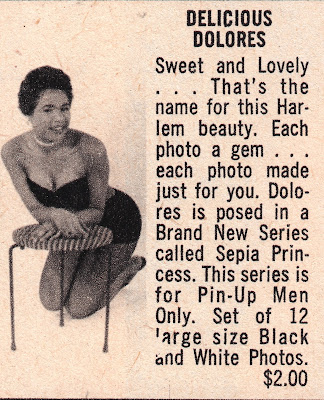Sepia Pin Up Calendar Storefront. This snapshot likely shows a photo studio associated with Sepia Magazine, which ran over 35 years but never achieved the reputation of the competitor Ebony or the mini-digest Jet. Still, it was a popular media source for the Black country within the country. Starting in 1947, Sepia was published in Texas by Good Publishing Company. Good was also responsible for the few African-American scandal magazines of the mid 20th Century. Hep, Jive and Bronze Thrills also came from Good. Interestingly, The owner was a white man named George Levitan, but the staff was largely African-American, and Mr. Levitan was a civil rights supporter.
This could be a satellite office. The magazine had nation-wide distribution, so it is possible a studio looking for glamour shots of African-American women would be in NYC or Chicago. It is also possible this was simply a storefront set up by an anonymous photographer using the Sepia name. What better way to attract talent? There is a similar snapshot for sale on a website which identifies the date around 1930, but that is unlikely.

One reason so few of the original Good Publications magazines are seen today is due to the "pass-along rate." Unlike, for example, issues of National Geographic, which are stockpiled in many garages in nearly mint but moldy condition, most of the race magazines were shared over and over until they wore out. They cost from 25 to 35 cents…and before the 1960s, there was little disposable income for the minority. They were seldom collected by libraries. A few examples of Good Magazines are shown here.
Original snapshot Sepia Pin-Up Calendar Storefront. No date, circa 1955? Collection Jim Linderman. Jim Linderman's book The Birth of Rock and Roll published by Dust to Digital is available for purchase HERE and HERE.








